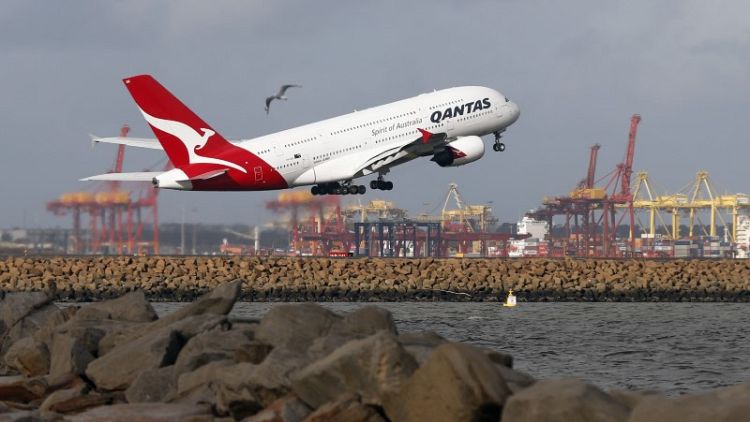By Jamie Freed
(Reuters) - Australia's Qantas Airways Ltd said on Thursday one of its Airbus SE A380 jets had experienced a rare "jolt" from wake turbulence after flying 20 nautical miles behind another one of its super-jumbos.
No passengers were injured and there was no aircraft damage from the incident which involved an A380 taking off from Los Angeles late on Sunday LA time bound for Melbourne, flying behind another Qantas A380 en route to Sydney, a Qantas spokesman said.
Wake turbulence forms behind an aircraft as it passes through the air, and air traffic control requires more spacing behind larger jets like the A380 to avoid it.
Wake turbulence is uncommon and typically involves a larger jet and a smaller aircraft rather than two super-jumbos.
In January 2017, wake turbulence behind an Emirates A380 sent a business jet into an uncontrolled descent, with the smaller plane losing nearly 9,000 feet before the crew was able to gain control, according to an interim report by German investigators.
The U.S. Federal Aviation Administration (FAA), which handled air traffic control during the Qantas incident, requires at least 5 nautical miles separation for all jets during the cruise phase of flight.
On take-off and landing, where there is a higher risk of wake turbulence, it specifies that Boeing 747s require 4.5 nautical miles of separation from an A380 and smaller jets up to 8 nautical miles. An A380 behind another A380 requires only a minimum separation distance.
"The trailing airplane, the Qantas 94, encountered some wake turbulence from the Qantas 12, and that caused a jolt to the airplane for a short period of time," Qantas Chief Technical Pilot Alex Passerini told a Sydney radio station.
"The airplane climbed maybe 100 feet or so and descended back to its cruising altitude, and the captain took action to avoid the further exposure to the wake vortex."
Australian television presenter Eddie McGuire, who was on board the flight, said the incident lasted about 10 seconds.
"It did have that feel of, you know when you go over the top of a rollercoaster and you just get a little bit of a feeling, and the plane did bank to port, to the left-hand side, a little bit," he said on Channel 9.
"But it steadied up after about 10 seconds, and I have to say that what the most reassuring part of the situation was that the Qantas pilot came on immediately and said we'd gone in to the back of the turbulence of the Sydney plane."
Qantas said it has notified the Australian Transport Safety Bureau (ATSB) about the incident. The ATSB said it had determined it did not require an investigation.
An Airbus spokesman said Qantas had reported the incident to the manufacturer. "The situation was handled fully in accordance with procedures and the aircraft performed as designed," he said.
(Reporting by Jamie Freed in Singapore; additional reporting by Tom Westbrook in Sydney; Editing by Nick Macfie)
